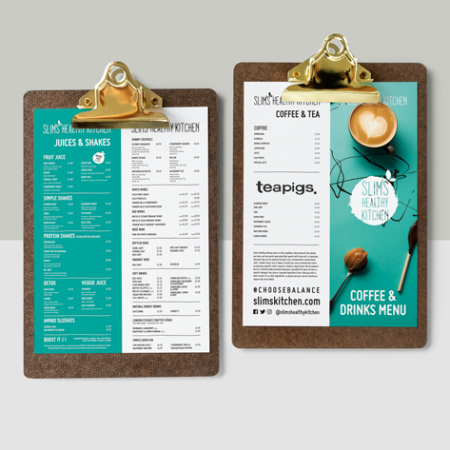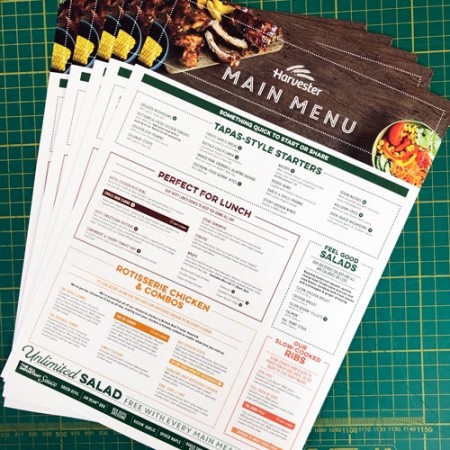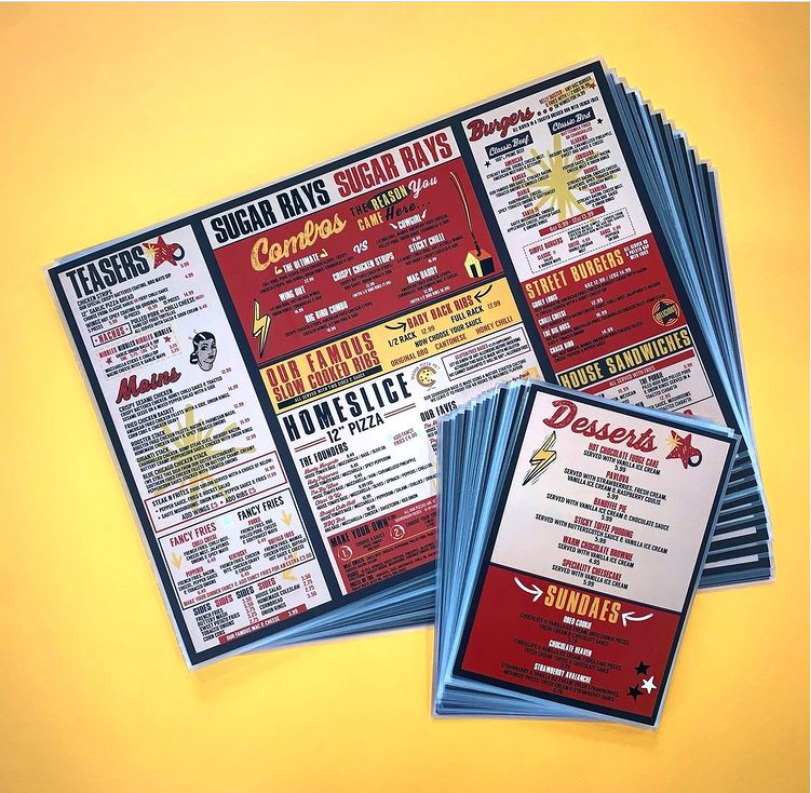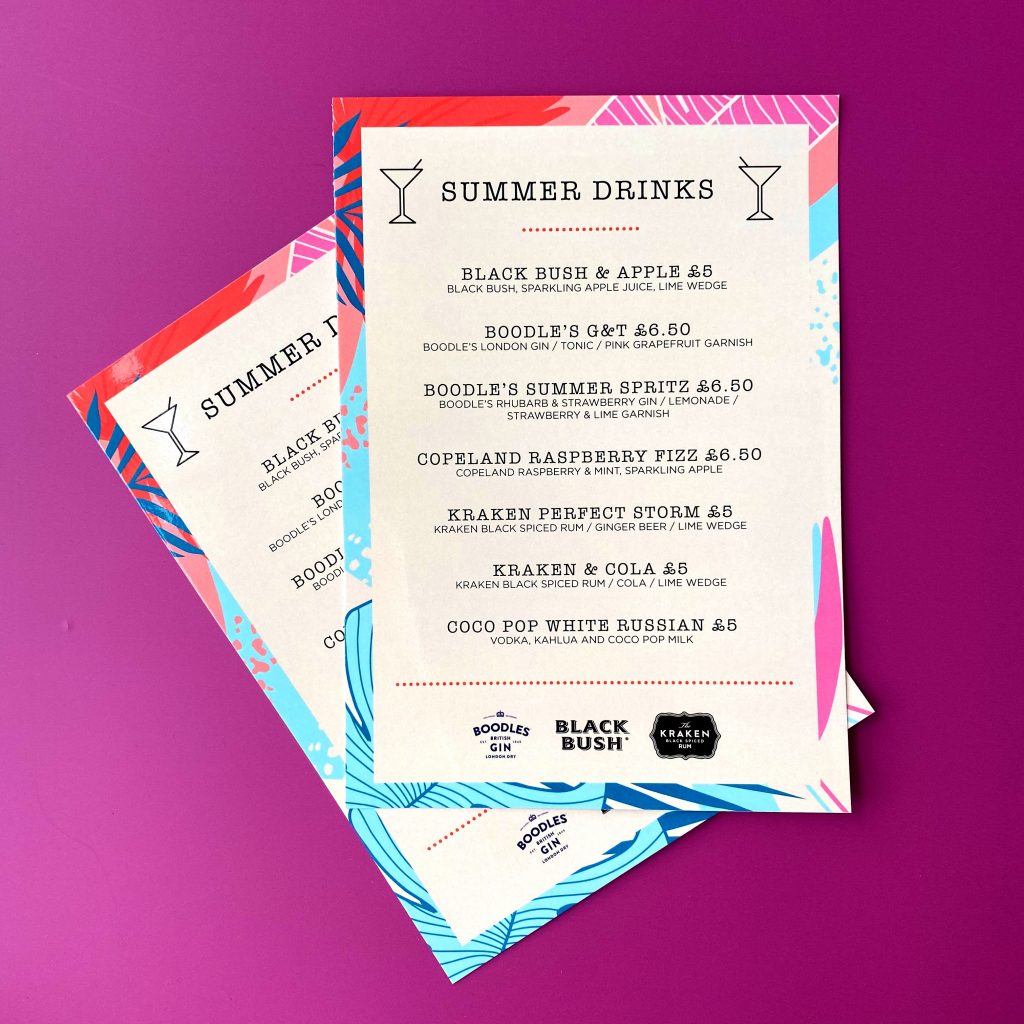A great menu design is an essential piece of your restaurant marketing toolkit. Not only capable of enticing your customers in with your curated list of delicious dishes, it is central to communicating your brand, guiding dining decisions and driving profit.
So, let’s take a look at 13 restaurant menu design hacks that get your customers ordering more!
1. Use a little psychology to boost sales
Recent research suggests customer tend to read menus as they would a book, starting at the top left corner and working across and down.
Furthermore, when scanning through menus that are laid out vertically, customers spend the most time looking at the first and last items of each section.
These areas are considered ‘prime real estate’ so if you have a next best selling dish in mind, these are the ideal spots to position them.
2. Organise your menu into easy to follow sections
Almost every menu has sections in a sequential order and for good reason.
Menu sections make it easy for customers to scan through and select what they want in a logical order, starting with the Drinks and Starters and ending with Desserts and Coffee.
This simple strategy results in faster ordering times and an easier ordering experience for both your customer and your wait staff.
3. Resist the temptation to overfill your menu
It’s important to resist the temptation to overcrowd your menu with too many options. Be selective, choose your new season dishes, sides and crowd pleasing favourites and stick to them.
Empty ‘whitespace’ on your menu is good. An over filled menu is not enjoyable to read, will take your customers longer to order and may be simply off-putting.
4. Frame best sellers with boxes or shading
Boxes and colour draw attention to grouped menu items and are often used by venues to promote the dishes they want to sell more of.
If you have items with a higher profit margin such as pasta, this is a simple yet effective strategy to boost sales.
5. Get creative with your menu descriptions
For your customers, the best part of a menu is without doubt the experience of reading the menu descriptions as they select what to eat.
So once you have refined your list of menu options, get mouths watering and build anticipation using descriptive language that is appetizing and evocative.
Studies show that good menu descriptions can elevate sales by more than 30% so this is the perfect opportunity to show your customers what is at the heart of your restaurant experience.
Perhaps central to your ethos is your farm to table process, your artisanal ingredients or expert handcraft methods. Share something about your process and brand will add value to your customers use phrasing to stimulate the senses and get taste buds tingling.
6. Leave off the currency signs
Pricing can be one of the trickier components to get right on a menu. However a good rule of thumb is to be aware of competitor pricing and find a balance between ensuring your pricing is profitable and affordable for your target audience.
When it comes to design, try to not make customers overly aware of how much they’re spending. Pricing should be clear but a new trend is to ‘soften the price’ by leaving off the pound signs entirely.
In fact, studies have shown that customers are likely to spend more when currency signs are removed.
7. Don’t use menu photos, unless…
Deciding whether or not to include photographs of your dishes should depend on your type of restaurant.
High-end venues typically avoid photos entirely and leave it to their customer’s imagination, while more affordable restaurants find that a few selected images boost their sales.
If you do decide to use photos, make sure they are professionally taken and of the highest quality.
Food photography will not appeal to everyone and it may be best to focus on crafting delicious descriptions to paint the picture instead.

8. Use illustrations and graphics to add personality
Instead of photography, you may want to consider using illustrations or other elements to create more visual interest. Graphics and illustration have more universal appeal and can be as simple as using decorative shading, ribbons and arrows.
These embellishments work as ‘eye magnets’ to guide your customer through the menu and highlight important sections or dishes and are a great way to share your restaurant’s personality through design.
9. Choose a font that’s easy to read
While it is important to keep your brand in mind it’s also crucial to ensure your menu is easy to read to create a positive experience for your customer.
Is your space dim and cosy or well lit? Is your audience typically older or younger? How large is your menu and how much writing can you visually accommodate without overwhelming your customer?
A quick guide is to remember that Serif and Sans Serif fonts are the easiest to read. Script and speciality fonts are perfect for adding flair and highlighting section titles.
Stick with no more than 3 fonts and use them to visually group information. For example: One font for menu items, one font for descriptions and one for category titles.
10. Choose menu colours that mirror your branding
Colour plays a huge role in setting the mood and theme of your restaurant. So make sure to align your colour choice with your brand identity and consider the following tips to get the most from your design.
- Is your restaurant casual or more formal? Energetic or calm, themed by cuisine? Think about what mood you want to achieve and choose colours that reflect this in your design.
- Always keep a high contrast between your text and the background to make it easy to read under different lighting.
- Use colour to highlight certain features or items on your menu layout.

11. Choose the right menu size for your customer
Menus can be printed large enough for two people to hold and share or smaller for individual use. Your needs will differ based on your style of dining, number of dishes and how often your menu changes.
We’ve gone in to more detail on this topic in our blog post Which restaurant menu size and layout is best?.
12. Proofread, proofread and proofread again.
Mistakes happen often on menus, so it’s important to ensure your hard work isn’t lost to an embarrassing typo.
Before locking in your menu print order you must proofread thoroughly.
The best method for proofreading is to read it carefully from right to left and ask two capable colleagues to do the same.
13. How many restaurant menus should I print?
An insider tip to follow is to base your menu print number off your seating capacity.
For wine and drinks calculate 25% your restaurant seating capacity. For Lunch and Dinner roughly 75% and for Dessert roughly 50% of your seating capacity.
We hope these 13 Restaurant Menu Design Hacks have got your menu ideas flowing!
If you need a little help creating a menu, our design team here at Kaizen Print is here to help your restaurant grow with a beautiful, affordable design. Reach out to us today to get started!




